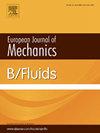A two-experiment approach to hydraulic jump scaling
IF 2.5
3区 工程技术
Q2 MECHANICS
引用次数: 0
Abstract
A hydraulic jump is a sudden rapid transition from a fast to a slower moving flow that is readily observed in open channels. The phenomenon has been extensively investigated both theoretically and experimentally, and is influenced by turbulence, gravity, wall friction, and fluid viscosity. The behaviour of a jump changes under scaling, which limits experimental investigations performed at scale, making scaled models unrepresentative. This issue is addressed in this paper with the introduction of a new experimental approach involving more than one scaled model. A new theory for scaling has recently appeared in the open literature that systematically removes scale effects by means of alternative similitude rules not available to dimensional analysis. This main focus in this paper is on the rule known as the first-order finite-similitude rule, involving two scaled experiments. The question addressed in the paper is whether it is possible, by means of additional scaled experiments, to capture more accurately hydraulic-jump behaviour. Both theoretical and experimentally-validated results are examined from the literature to support the contention that an additional scaled experiment provides significantly improved outcomes.
求助全文
约1分钟内获得全文
求助全文
来源期刊
CiteScore
5.90
自引率
3.80%
发文量
127
审稿时长
58 days
期刊介绍:
The European Journal of Mechanics - B/Fluids publishes papers in all fields of fluid mechanics. Although investigations in well-established areas are within the scope of the journal, recent developments and innovative ideas are particularly welcome. Theoretical, computational and experimental papers are equally welcome. Mathematical methods, be they deterministic or stochastic, analytical or numerical, will be accepted provided they serve to clarify some identifiable problems in fluid mechanics, and provided the significance of results is explained. Similarly, experimental papers must add physical insight in to the understanding of fluid mechanics.

 求助内容:
求助内容: 应助结果提醒方式:
应助结果提醒方式:


